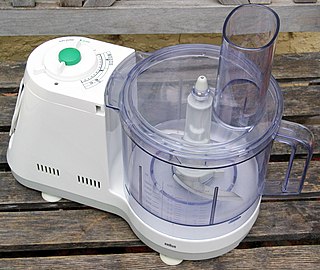Related Research Articles

Assistive technology (AT) is a term for assistive, adaptive, and rehabilitative devices for people with disabilities and the elderly. Disabled people often have difficulty performing activities of daily living (ADLs) independently, or even with assistance. ADLs are self-care activities that include toileting, mobility (ambulation), eating, bathing, dressing, grooming, and personal device care. Assistive technology can ameliorate the effects of disabilities that limit the ability to perform ADLs. Assistive technology promotes greater independence by enabling people to perform tasks they were formerly unable to accomplish, or had great difficulty accomplishing, by providing enhancements to, or changing methods of interacting with, the technology needed to accomplish such tasks. For example, wheelchairs provide independent mobility for those who cannot walk, while assistive eating devices can enable people who cannot feed themselves to do so. Due to assistive technology, disabled people have an opportunity of a more positive and easygoing lifestyle, with an increase in "social participation," "security and control," and a greater chance to "reduce institutional costs without significantly increasing household expenses." In schools, assistive technology can be critical in allowing students with disabilities access the general education curriculum. Students who experience challenges writing or keyboarding, for example, can use voice recognition software instead. Assistive technologies assist people who are recovering from strokes and people who have abstained injuries that effect their daily tasks.

A curb cut (U.S.), curb ramp, depressed curb,dropped kerb (UK), pram ramp, or kerb ramp (Australia) is a solid ramp graded down from the top surface of a sidewalk to the surface of an adjoining street. It is designed primarily for pedestrian usage and commonly found in urban areas where pedestrian activity is expected. In comparison with a conventional curb a curb cut is finished at an intermediate gradient that connects both surfaces, sometimes with tactile paving.

Accessibility is the design of products, devices, services, vehicles, or environments so as to be usable by people with disabilities. The concept of accessible design and practice of accessible development ensures both "direct access" and "indirect access" meaning compatibility with a person's assistive technology.

A food processor is a kitchen appliance used to facilitate repetitive tasks in the preparation of food. Today, the term almost always refers to an electric-motor-driven appliance, although there are some manual devices also referred to as "food processors".
Universal design is the design of buildings, products or environments to make them accessible to people, regardless of age, disability or other factors. It addresses common barriers to participation by creating things that can be used by the maximum number of people possible. Curb cuts or sidewalk ramps, which are essential for people in wheelchairs but also used by all, are a common example of universal design.
Inclusive design is a design process in which a product, service, or environment is designed to be usable for as many people as possible, particularly groups who are traditionally excluded from being able to use an interface or navigate an environment. Its focus is on fulfilling as many user needs as possible, not just as many users as possible. Historically, inclusive design has been linked to designing for people with physical disabilities, and accessibility is one of the key outcomes of inclusive design. However, rather than focusing on designing for disabilities, inclusive design is a methodology that considers many aspects of human diversity that could affect a person's ability to use a product, service, or environment, such as ability, language, culture, gender, and age. The Inclusive Design Research Center reframes disability as a mismatch between the needs of a user and the design of a product or system, emphasizing that disability can be experienced by any user. With this framing, it becomes clear that inclusive design is not limited to interfaces or technologies, but may also be applied to the design of policies and infrastructure.
Cuisinart is an American kitchen appliance and cookware brand owned by Conair Corporation. Cuisinart was founded in 1971 by Carl Sontheimer and initially produced food processors, which were introduced at a food show in Chicago in 1973. The name "Cuisinart" became synonymous with "food processor." The brand's name is a portmanteau of "cuisine" and "art." Cuisinart was purchased by Conair Corporation in 1989.

Inclusion, in relation to persons with disabilities, is defined as including individuals with disabilities in everyday activities and ensuring they have access to resources and opportunities in ways that are similar to their non-disabled peers. Disability rights advocates define true inclusion as results-oriented, rather than focused merely on encouragement. To this end, communities, businesses, and other groups and organizations are considered inclusive if people with disabilities do not face barriers to participation and have equal access to opportunities and resources.

Accessible tourism is the ongoing endeavor to ensure tourist destinations, products, and services are accessible to all people, regardless of their physical or intellectual limitations, disabilities or age. It encompasses publicly and privately owned and operated tourist locations. The goal of accessible tourism is to create inclusivity of all including those traveling with children, people with disabilities, as well as seniors. This allows those with access requirements to be able to function as an independent using products following the universal design principle, a variety of services, and different environments.

A wheelchair is a chair with wheels, used when walking is difficult or impossible due to illness, injury, problems related to old age, or disability.

The International Symbol of Access (ISA), also known as the (International) Wheelchair Symbol, denotes areas where access has been improved, mostly for those with disabilities. It consists of a usually blue square overlaid in white with a stylized image of a person in a wheelchair. It is maintained as an international standard, ISO 7001 image of the International Commission on Technology and Accessibility (ICTA), a committee of Rehabilitation International (RI).
Universal instructional design (UID) or universal design for instruction (UDI) is an educational framework for applying universal design principles to learning environments with a goal toward greater accessibility for all students, including students with disabilities. UDI involves considering the potential needs of all learners when designing and delivering instruction by identifying and eliminating unnecessary barriers to teaching and learning while maintaining academic rigor. UDI is thus proactive and benefits all students, in contrast to providing accommodations for a specific student.
CEN/CENELEC Guide 6: Guidelines for standards developers to address the needs of older persons and persons with disabilities is a document for participants in standardisation activities at CEN and CENELEC that contains guidance for the creation and the revision of standards to ensure greater accessibility of products and services. The document is a "Guide", in other words, not a European Standard (EN). The guide is identical to ISO/IEC Guide 71 and was adopted by both the CEN Technical Board and the CENELEC Technical Board, and published in January 2002. The adoption of CEN/CENELEC Guide 6 resulted from a European mandate to the European standardisation organisations, and the European Commission is funding projects to promote the use of the Guide.
Design for All in the context of information and communications technology (ICT) is the conscious and systematic effort to proactively apply principles, methods and tools to promote universal design in computer-related technologies, including Internet-based technologies, thus avoiding the need for a posteriori adaptations, or specialised design.

Morgan's Wonderland is an accessibility-focused theme park in San Antonio, Texas founded in 2010. The park was developed by Gordon Hartman, a former homebuilder from San Antonio. Morgan's Wonderland has had over a net million guests since its opening in 2010. The park features several attractions including rides, playgrounds, gardens, a catch-and-release fishing lake, a special-event center, and 575-seat amphitheater. The park's focus on accessibility makes it free for disabled individuals to attend the park.
The physically integrated dance movement is part of the disability culture movement, which recognizes and celebrates the first-person experience of disability, not as a medical model construct but as a social phenomenon, through artistic, literary, and other creative means.
Transgenerational design is the practice of making products and environments compatible with those physical and sensory impairments associated with human aging and which limit major activities of daily living. The term transgenerational design was coined in 1986, by Syracuse University industrial design professor James J. Pirkl to describe and identify products and environments that accommodate, and appeal to, the widest spectrum of those who would use them—the young, the old, the able, the disabled—without penalty to any group. The transgenerational design concept emerged from his federally funded design-for-aging research project, Industrial design Accommodations: A Transgenerational Perspective. The project's two seminal 1988 publications provided detailed information about the aging process; informed and sensitized industrial design professionals and design students about the realities of human aging; and offered a useful set of guidelines and strategies for designing products that accommodate the changing needs of people of all ages and abilities.
Accessible housing refers to the construction or modification of housing to enable independent living for persons with disabilities. Accessibility is achieved through architectural design, but also by integrating accessibility features such as modified furniture, shelves and cupboards, or even electronic devices in the home.
Disability rights are not specifically addressed by legislation in New Zealand. Instead, disability rights are addressed through human rights legislation. Human rights in New Zealand are protected by the New Zealand Bill of Rights Act 1990 and the Human Rights Act 1993. New Zealand also signed and ratified the United Nations Convention on the Rights of Persons with Disabilities (CRPD) in 2008.
Social Networks and Archival Context (SNAC) is an online project for discovering, locating, and using distributed historical records in regard to individual people, families, and organizations.
References
- ↑ "Harrison, Marc, 1936-1998 @ SNAC". snaccooperative.org. Retrieved 2017-10-20.
- ↑ "Universal Design : Digital Exhibit". Hagley Museum & Library. Retrieved 2020-10-28.
- ↑ "Harrison, Marc, 1936-1998 @ SNAC". snaccooperative.org.
- ↑ "Marc Harrison". Industrial Designers Society of America - IDSA. 2010-06-16. Retrieved 2018-10-17.
- ↑ "Pratt Institute". www.pratt.edu. Retrieved 2018-10-17.
- ↑ "Marc Harrison". Industrial Designers Society of America - IDSA. 16 June 2010.
- ↑ "The RL Mace Universal Design Institute". www.udinstitute.org.
- ↑ "Marc Harrison - Human Factors". Hagley. 17 July 2017.
- ↑ Glusac, Elaine (2008). "Shopping in Providence, R.I.: risd/works". The New York Times. ISSN 0362-4331 . Retrieved 2017-10-20.
- ↑ "Marc Harrison (Industrial Design, Alumnus)". Pratt Institute. Retrieved 2017-10-20.
- ↑ "Visionary Marc Harrison". Edible Rhody.
- ↑ "Marc Harrison - Human Factors". Hagley.
- ↑ "Marc Harrison - Human Factors". Hagley.
- ↑ "Marc Harrison - Human Factors". Hagley. 17 July 2017.